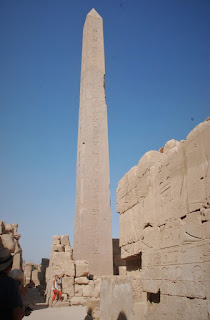Our AirBNB flat was in close proximity to the most popular sites which made it possible for us to walk to them all. With parks, riverside walkways, sidewalk cafes, and museums, Paris is a walkers' dream. As our stay was short we wanted to cram in as much as possible.
Our first day, we walked down the Avenue des Champs-Élysées which is 1.9 km/1.2 mi long. This most famous and most beautiful avenue in the world is lined with rows of London Plane trees, cafes, theatres, and upscale boutique shops of luxury. It stretches from the Arc de Triomphe to the Jardin des Tuileries and the Louvre that site along the Seine River.
Champs-Élysées from Arc de Triomphe, looking towards Louvre
Of course we visited the Musée du Louvre, the largest (15 acres in size) and arguably the most famous museum in the world. Within its walls, the Museum is filled with more than 380,000 objects including sculptures, drawings, and about 38,000 paintings by famous artists including the famous Mona Lisa and the Venus de Milo. Did you know that the Mona Lisa is quite small (53x77 cm/21x30 in) and is displayed behind bulletproof glass and a roped off area, keeping you at an untouchable distance for viewing. But many others are whopping big!
Grand art by an old master
Wreck of the Medusa
The magnificence of the Museum's treasures are equalled by the fabulous building that houses them where paintings and frescoes are displayed on a pallet of the most splendid architecture.
A roof canvas
The building has served both as a fortress in 1190 and a palace in the 16th century, undergoing numerous reconstructions, additions, deletions, etc. to the present day. The modern and controversial addition that serves as the entry for the thousands of visitors is the glaring glass pyramid.
Musée du Louvre (photo from web)
During our visit to the Louvre, we inquired about the lack of impressionists' art and were informed that they were to be seen at the Musée d'Orsay. So that became our next art museum venue. There we saw pieces such as Monets, Renoirs, etc. and post-impressionists Cezannes, van Goghs, Gauguins, etc. We were surprised and pleased to see paintings by our hometown famous artist, Emily Carr, as well as other landscape painters of the Group of Seven.
A leisurely stroll from the Louvre along the banks of the Seine brought us to the famous gothic architecture of the Notre Dame Cathedral. Our expectations however were dampened by the dreary interior and the exterior that showed the effects of unchecked erosion.
We didn't see the hunchback!
The Eiffel Tower, in spite of the many tourists and in contrast to Notre Dame, was grander than we expected. At 81 stories tall, we had stomach butterflies as the elevator ascended to the peak. Perfect weather presented us a spectacular view below that stretched over the city for miles. With a thrilling nervousness, we walked the perimeter and peeked into Gustav Eiffel's cozy and romantic private apartment, complete with mannequins of himself and Thomas Edison. (Eiffel never allowed anyone to stay in his apartment, even turning down offers of huge sums of money.)
Needs no description
Best view in Paris
At the western end of the Champs-Élysées stands the iconic Arc de Triomphe. It was ordered constructed by Napoleon as an honour to his soldiers returning from war. We climbed the many interior stairs to the top for the photo op looking down the grand Avenue. At the base also lies the Tomb of the Unknown Soldier with a memorial flame lit everyday at 18:30.
The Arc - hub of splendid avenues
A visit to Paris would be incomplete without strolling the alleys and avenues amongst rich architecture and lounging at the ubiquitous sidewalk cafes sampling the authentic French cuisine while watching the world pass by.
Sidewalk cafes
Large cities are not our favourite places but we can make an exception with Gay Paree (Joyful Paris).





















































